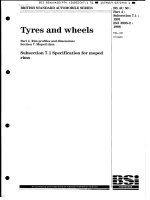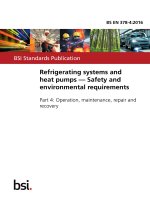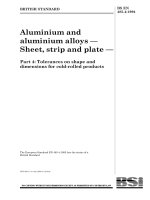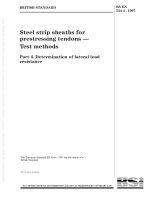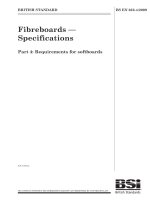Bsi bs en 62056 4 7 2016
Bạn đang xem bản rút gọn của tài liệu. Xem và tải ngay bản đầy đủ của tài liệu tại đây (2.57 MB, 44 trang )
BS
BSEN
EN62056-4-7:2016
62056-4-7:2015
BSI Standards Publication
Electricity metering
data exchange —
The DLMS/COSEM suite
Part 4-7: DLMS/COSEM transport
layer for IP networks
62056-4-7:2016
BS EN 62056-4-7:2015
BRITISH
STANDARD
BRITISH STANDARD
National foreword
This British Standard is the UK implementation of EN 62056-4-7:2016. It is
identical to IEC 62056-4-7:2015. It supersedes BS EN 62056-47:2007 which is
withdrawn.
The UK participation in its preparation was entrusted to Technical
Committee PEL/13, Electricity Meters.
A list of organizations represented on this committee can be obtained on
request to its secretary.
This publication does not purport to include all the necessary provisions of
a contract. Users are responsible for its correct application.
© The British Standards Institution 2016.
Published by BSI Standards Limited 2016
ISBN 978 0 580 86668 5
ICS 17.220.01; 35.100.40; 35.110; 91.140.50
Compliance with a British Standard cannot confer immunity from
legal obligations.
This British Standard was published under the authority of the
Standards Policy and Strategy Committee on 31 December 2016.
Amendments/corrigenda issued since publication
Date
Text affected
EUROPEAN STANDARD
EN 62056-4-7
NORME EUROPÉENNE
EUROPÄISCHE NORM
December 2016
ICS 17.220; 35.110; 91.140.50
Supersedes EN 62056-47:2007
English Version
Electricity metering data exchange - The DLMS/COSEM suite Part 4-7: DLMS/COSEM transport layer for IP networks
(IEC 62056-4-7:2015)
Échange des données de comptage de l'électricité - La
suite DLMS/COSEM - Partie 4-7: Couche transport
DLMS/COSEM pour réseaux IP
(IEC 62056-4-7:2015)
Datenkommunikation der elektrischen Energiemessung DLMS/COSEM - Teil 4-7: DLMS/COSEM Transportschicht
für IP-Netzwerke
(IEC 62056-4-7:2015)
This European Standard was approved by CENELEC on 2015-06-24. CENELEC members are bound to comply with the CEN/CENELEC
Internal Regulations which stipulate the conditions for giving this European Standard the status of a national standard without any alteration.
Up-to-date lists and bibliographical references concerning such national standards may be obtained on application to the CEN-CENELEC
Management Centre or to any CENELEC member.
This European Standard exists in three official versions (English, French, German). A version in any other language made by translation
under the responsibility of a CENELEC member into its own language and notified to the CEN-CENELEC Management Centre has the
same status as the official versions.
CENELEC members are the national electrotechnical committees of Austria, Belgium, Bulgaria, Croatia, Cyprus, the Czech Republic,
Denmark, Estonia, Finland, Former Yugoslav Republic of Macedonia, France, Germany, Greece, Hungary, Iceland, Ireland, Italy, Latvia,
Lithuania, Luxembourg, Malta, the Netherlands, Norway, Poland, Portugal, Romania, Slovakia, Slovenia, Spain, Sweden, Switzerland,
Turkey and the United Kingdom.
European Committee for Electrotechnical Standardization
Comité Européen de Normalisation Electrotechnique
Europäisches Komitee für Elektrotechnische Normung
CEN-CENELEC Management Centre: Avenue Marnix 17, B-1000 Brussels
© 2016 CENELEC All rights of exploitation in any form and by any means reserved worldwide for CENELEC Members.
Ref. No. EN 62056-4-7:2016 E
BS EN 62056-4-7:2016
EN 62056-4-7:2016
European foreword
The text of document 13/1570/CDV, future edition 1 of IEC 62056-4-7, prepared by IEC/TC 13
"Electrical energy measurement and control" was submitted to the IEC-CENELEC parallel vote and
approved by CENELEC as EN 62056-4-7:2016.
The following dates are fixed:
•
latest date by which the document has to be
implemented at national level by
publication of an identical national
standard or by endorsement
(dop)
2017-06-09
•
latest date by which the national
standards conflicting with the
document have to be withdrawn
(dow)
2019-12-09
This document supersedes EN 62056-47:2007.
Attention is drawn to the possibility that some of the elements of this document may be the subject of
patent rights. CENELEC [and/or CEN] shall not be held responsible for identifying any or all such
patent rights.
This document has been prepared under a mandate given to CENELEC by the European Commission
and the European Free Trade Association.
Endorsement notice
The text of the International Standard IEC 62056-4-7:2015 was approved by CENELEC as a
European Standard without any modification.
BS EN 62056-4-7:2016
EN 62056-4-7:2016
Annex ZA
(normative)
Normative references to international publications
with their corresponding European publications
The following documents, in whole or in part, are normatively referenced in this document and are
indispensable for its application. For dated references, only the edition cited applies. For undated
references, the latest edition of the referenced document (including any amendments) applies.
NOTE 1 When an International Publication has been modified by common modifications, indicated by (mod), the relevant
EN/HD applies.
NOTE 2 Up-to-date information on the latest versions of the European Standards listed in this annex is available here:
www.cenelec.eu
Publication
Year
Title
IEC 60050-300
2001
International Electrotechnical Vocabulary (IEV) - Electrical and electronic
measurements and measuring instruments
- Part 311: General terms relating to
measurements Part 312: General terms relating to
electrical measurements Part 313: Types of electrical measuring
instruments Part 314: Specific terms according to the
type of instrument
-
IEC/TR 62051
1999
Electricity metering - Glossary of terms
-
-
IEC/TR 62051-1
2004
Electricity metering - Data exchange for
meter reading, tariff and load control Glossary of terms Part 1: Terms related to data exchange
with metering equipment using
DLMS/COSEM
-
-
IEC 62056-5-3
2013
Electricity metering data exchange EN 62056-5-3
The DLMS/COSEM suite Part 5-3: DLMS/COSEM application layer
2014
1)
IEC 62056-6-2
2013
Electricity metering data exchange The DLMS/COSEM suite Part 6-2: COSEM interface classes
EN 62056-6-2
2013
2)
IEC 62056-9-7
2013
Electricity metering data exchange The DLMS/COSEM suite Part 9-7: Communication profile
for TCP-UDP/IP networks
EN 62056-9-7
2013
STD 0006
-
User Datagram Protocol
-
-
STD 0007
-
Transmission Control Protocol
-
-
1)
2)
EN/HD
Superseded by EN 62056-5-3:2016 (IEC 62056-5-3:2016): DOW = 2019-12-09.
Superseded by EN 62056-6-2:2016 (IEC 62056-6-2:2016): DOW = 2019-12-09.
Year
–2–
BS EN 62056-4-7:2015
62056-4-7:2016
62056-4-7:2015©IEC
IEC 2015
2015
IECIEC
62056-4-7:2015
CONTENTS
FOREWORD ........................................................................................................................... 4
INTRODUCTION ..................................................................................................................... 6
1
Scope .............................................................................................................................. 7
2
Normative references ...................................................................................................... 7
3
Terms, definitions and abbreviations ............................................................................... 8
3.1
Terms and definitions .............................................................................................. 8
3.2
Abbreviations .......................................................................................................... 8
4
Overview ......................................................................................................................... 9
5
The DLMS/COSEM connection-less, UDP-based transport layer ................................... 10
5.1
General ................................................................................................................. 10
5.2
Service specification for the DLMS/COSEM UDP-based transport layer ................ 11
5.2.1
General ......................................................................................................... 11
5.2.2
The UDP-DATA service ................................................................................. 12
5.3
Protocol specification for the DLMS/COSEM UDP-based transport layer ............... 14
5.3.1
General ......................................................................................................... 14
5.3.2
The wrapper protocol data unit (WPDU) ......................................................... 14
5.3.3
The DLMS/COSEM UDP-based transport layer protocol data unit .................. 15
5.3.4
Reserved wrapper port numbers (wPorts) ...................................................... 16
5.3.5
Protocol state machine .................................................................................. 16
6
The DLMS/COSEM connection-oriented, TCP-based transport layer ............................. 16
6.1
General ................................................................................................................. 16
6.2
Service specification for the DLMS/COSEM TCP-based transport layer ................ 17
6.2.1
General ......................................................................................................... 17
6.2.2
The TCP-CONNECT service .......................................................................... 18
6.2.3
The TCP-DISCONNECT service .................................................................... 21
6.2.4
The TCP-ABORT service ............................................................................... 23
6.2.5
The TCP-DATA service .................................................................................. 24
6.3
Protocol specification for the DLMS/COSEM TCP-based transport layer ............... 26
6.3.1
General ......................................................................................................... 26
6.3.2
The wrapper protocol data unit (WPDU) ......................................................... 26
6.3.3
The DLMS/COSEM TCP-based transport layer protocol data unit .................. 27
6.3.4
Reserved wrapper port numbers .................................................................... 27
6.3.5
Definition of the procedures ........................................................................... 27
Annex A (informative) Converting OSI-style TL services to and from RFC-style TCP
function calls......................................................................................................................... 32
A.1
Transport layer and TCP connection establishment ............................................... 32
A.2
Closing a transport layer and a TCP connection .................................................... 33
A.3
TCP connection abort ........................................................................................... 34
A.4
Data transfer using the TCP-DATA service ........................................................... 35
INDEX .................................................................................................................................. 37
Bibliography .......................................................................................................................... 38
Figure 1 – DLMS/COSEM as a standard Internet application protocol ..................................... 9
Figure 2 – Transport layers of the DLMS/COSEM_on_IP profile ............................................ 10
Figure 3 – Services of the DLMS/COSEM connection-less, UDP-based transport layer ......... 12
BS EN 62056-4-7:2015
62056-4-7:2016
IEC
2015
IEC 62056-4-7:2015
62056-4-7:2015©
IEC
2015
–3–
Figure 4 – The wrapper protocol data unit (WPDU) ............................................................... 15
Figure 5 – The DLMS/COSEM connection-less, UDP-based transport layer PDU (UDPPDU) .................................................................................................................................... 15
Figure 6 – Services of the DLMS/COSEM connection-oriented,TCP-based transport
layer ..................................................................................................................................... 18
Figure 7 – The TCP packet format ........................................................................................ 27
Figure 8 – TCP connection establishment ............................................................................. 28
Figure 9 – TCP disconnection ............................................................................................... 29
Figure 10 – Data transfer using the DLMS/COSEM TCP-based transport layer ..................... 30
Figure 11 – High-level state transition diagram for the wrapper sublayer ............................... 31
Figure A.1 – TCP connection state diagram .......................................................................... 32
Figure A.2 – MSC and state transitions for establishing a transport layer and TCP
connection ............................................................................................................................ 33
Figure A.3 – MSC and state transitions for closing a transport layer and TCP
connection ............................................................................................................................ 34
Figure A.4 – Polling the TCP sublayer for TCP abort indication ............................................. 34
Figure A.5 – Sending an APDU in three TCP packets ........................................................... 35
Figure A.6 – Receiving the message in several packets ........................................................ 36
Table 1 – Reserved wrapper port numbers in the UDP-based DLMS/COSEM TL .................. 16
–4–
BS EN 62056-4-7:2015
62056-4-7:2016
62056-4-7:2015©IEC
IEC 2015
2015
IECIEC
62056-4-7:2015
INTERNATIONAL ELECTROTECHNICAL COMMISSION
____________
ELECTRICITY METERING DATA EXCHANGE –
THE DLMS/COSEM SUITE –
Part 4-7: DLMS/COSEM transport layer for IP networks
FOREWORD
1) The International Electrotechnical Commission (IEC) is a worldwide organization for standardization comprising
all national electrotechnical committees (IEC National Committees). The object of IEC is to promote
international co-operation on all questions concerning standardization in the electrical and electronic fields. To
this end and in addition to other activities, IEC publishes International Standards, Technical Specifications,
Technical Reports, Publicly Available Specifications (PAS) and Guides (hereafter referred to as “IEC
Publication(s)”). Their preparation is entrusted to technical committees; any IEC National Committee interested
in the subject dealt with may participate in this preparatory work. International, governmental and nongovernmental organizations liaising with the IEC also participate in this preparation. IEC collaborates closely
with the International Organization for Standardization (ISO) in accordance with conditions determined by
agreement between the two organizations.
2) The formal decisions or agreements of IEC on technical matters express, as nearly as possible, an international
consensus of opinion on the relevant subjects since each technical committee has representation from all
interested IEC National Committees.
3) IEC Publications have the form of recommendations for international use and are accepted by IEC National
Committees in that sense. While all reasonable efforts are made to ensure that the technical content of IEC
Publications is accurate, IEC cannot be held responsible for the way in which they are used or for any
misinterpretation by any end user.
4) In order to promote international uniformity, IEC National Committees undertake to apply IEC Publications
transparently to the maximum extent possible in their national and regional publications. Any divergence
between any IEC Publication and the corresponding national or regional publication shall be clearly indicated in
the latter.
5) IEC itself does not provide any attestation of conformity. Independent certification bodies provide conformity
assessment services and, in some areas, access to IEC marks of conformity. IEC is not responsible for any
services carried out by independent certification bodies.
6) All users should ensure that they have the latest edition of this publication.
7) No liability shall attach to IEC or its directors, employees, servants or agents including individual experts and
members of its technical committees and IEC National Committees for any personal injury, property damage or
other damage of any nature whatsoever, whether direct or indirect, or for costs (including legal fees) and
expenses arising out of the publication, use of, or reliance upon, this IEC Publication or any other IEC
Publications.
8) Attention is drawn to the Normative references cited in this publication. Use of the referenced publications is
indispensable for the correct application of this publication.
9) Attention is drawn to the possibility that some of the elements of this IEC Publication may be the subject of
patent rights. IEC shall not be held responsible for identifying any or all such patent rights.
The International Electrotechnical Commission (IEC) draws attention to the fact that it is claimed that compliance
with this International Standard may involve the use of a maintenance service concerning the stack of protocols on
which the present standard IEC 62056-4-7 is based.
The IEC takes no position concerning the evidence, validity and scope of this maintenance service.
The provider of the maintenance service has assured the IEC that he is willing to provide services under
reasonable and non-discriminatory terms and conditions for applicants throughout the world. In this respect, the
statement of the provider of the maintenance service is registered with the IEC. Information may be obtained from:
DLMS User Association
Zug/Switzerland
www.dlms.com
BS EN 62056-4-7:2016
62056-4-7:2015
IEC
2015
IEC 62056-4-7:2015
62056-4-7:2015©
IEC
2015
–5–
International Standard IEC 62056-4-7 has been prepared by IEC technical committee 13:
Electrical energy measurement and control.
This first edition cancels and replaces IEC 62056-47 published in 2006. This edition
constitutes a technical revision.
This edition includes the following significant technical changes with respect to the previous
edition:
a) This standard is applicable now both for IP4 and IPv6 networks;
b) Latest editions of the IEC 62056 suite are referenced.
c) DLMS/COSEM IANA-registered port numbers added.
The text of this standard is based on the following documents:
CDV
Report on voting
13/1570/CDV
13/1595/RVC
Full information on the voting for the approval of this standard can be found in the report on
voting indicated in the above table.
This publication has been drafted in accordance with the ISO/IEC Directives, Part 2.
A list of all parts in the IEC 62056 series, published under the general title Electricity metering
data exchange – The DLMS/COSEM suite, can be found on the IEC website.
The committee has decided that the contents of this publication will remain unchanged until
the stability date indicated on the IEC web site under "" in the data
related to the specific publication. At this date, the publication will be
•
reconfirmed,
•
withdrawn,
•
replaced by a revised edition, or
•
amended.
IMPORTANT – The 'colour inside' logo on the cover page of this publication indicates
that it contains colours which are considered to be useful for the correct
understanding of its contents. Users should therefore print this document using a
colour printer.
–6–
BS EN 62056-4-7:2015
62056-4-7:2016
62056-4-7:2015©IEC
IEC 2015
2015
IECIEC
62056-4-7:2015
INTRODUCTION
This standard specifies the DLMS/COSEM transport layer for IP (IPv4 or IPv6) networks. It
shall be read together with IEC 62056-9-7:2013, Electricity metering data exchange – The
DLMS/COSEM suite – Part 9-7: Communication profile for TCP-UDP/IP networks.
BS EN 62056-4-7:2015
62056-4-7:2016
IEC
2015
IEC 62056-4-7:2015
62056-4-7:2015©
IEC
2015
–7–
ELECTRICITY METERING DATA EXCHANGE –
THE DLMS/COSEM SUITE –
Part 4-7: DLMS/COSEM transport layer for IP networks
1
Scope
This part of IEC 62056 specifies a connection-less and a connection oriented transport layer
(TL) for DLMS/COSEM communication profiles used on IP networks.
These TLs provide OSI-style services to the service user DLMS/COSEM AL. The connectionless TL is based on the Internet Standard User Datagram Protocol (UDP). The connectionoriented TL is based on the Internet Standard Transmission Control Protocol (TCP).
The DLMS/COSEM TL consists of the UDP or TCP transport layer TCP and an additional
sublayer, called wrapper.
Annex A shows how the OSI-style TL services can be converted to and from UDP and TCP
function calls.
2
Normative references
The following documents, in whole or in part, are normatively referenced in this document and
are indispensable for its application. For dated references, only the edition cited applies. For
undated references, the latest edition of the referenced document (including any
amendments) applies.
IEC 60050-300:2001, International Electrotechnical Vocabulary (IEV) – Electrical and
electronic measurements and measuring instruments – Part 311: General terms relating to
measurements − Part 312: General terms relating to electrical measurements − Part 313:
Types of electrical measuring instruments − Part 314: Specific terms according to the type of
instrument
IEC TR 62051:1999, Electricity metering – Glossary of terms
IEC TR 62051-1:2004, Electricity metering – Data exchange for meter reading, tariff and load
control – Glossary of terms – Part 1: Terms related to data exchange with metering equipment
using DLMS/COSEM
IEC 62056-5-3:2013, Electricity metering data exchange – The DLMS/COSEM suite –
Part 5-3: DLMS/COSEM application layer 1
IEC 62056-6-2:2013, Electricity metering data exchange – The DLMS/COSEM suite –
Part 6-2: COSEM interface classes 2
______________
1 Edition 2 of IEC 62056-5-3 to be published.
2 Edition 2 of IEC 62056-6-2 to be published.
–8–
BS EN 62056-4-7:2015
62056-4-7:2016
62056-4-7:2015©IEC
IEC 2015
2015
IECIEC
62056-4-7:2015
IEC 62056-9-7:2013, Electricity metering data exchange – the DLMS/COSEM suite –
Part 9-7: Communication profile for TCP-UDP/IP networks
STD 0006, User Datagram Protocol. Edited by Jon Postel, August 1980. Available from:
/>STD 0007, Transmission Control Protocol. Edited by Jon Postel, September 1981. Available
from: />NOTE See also Bibliography for other related Internet RFCs.
3
Terms, definitions and abbreviations
3.1
Terms and definitions
For the purposes of this document, the terms and definitions given in IEC 60050-300,
IEC TR 62051 and IEC TR 62051-1 apply as well as the following:
3.1.1
application process
an element within a real open system which performs the information processing for a
particular application
[SOURCE: ISO/IEC 7498-1: 1994, 4.1.4]
3.1.2
application entity
system-independent application activities that are made available as application services to
the application agent, e.g., a set of application service elements that together perform all or
part of the communication aspects of an application process
3.2
Abbreviations
APDU
Application Layer Protocol Data Unit
AL
Application Layer
AP
Application Process
AE
Application Entity
COSEM
COmpanion Specification for Energy Metering
DHCP
Dynamic Host Configuration Protocol
DLMS
Device Language Message Sepcification
COSEM_on_IP
The TCP-UDP/IP based COSEM communication profile
FTP
File Transfer Protocol
HTTP
HyperText Transfer Protocol
IANA
Internet Assigned Numbers Authority
IP
Internet Protocol
PDU
Protocol Data Unit
PAR
Positive Acknowledgement with Retransmission
SNMP
Simple Network Management Protocol
TCP
Transmission Control Protocol
TFTP
Trivial File Transfer Protocol
TL
Transport Layer
UDP
User Datagram Protocol
BS EN 62056-4-7:2015
62056-4-7:2016
IEC
2015
IEC 62056-4-7:2015
62056-4-7:2015©
IEC
2015
WPDU
4
–9–
Wrapper Protocol Data Unit
Overview
In the DLMS/COSEM_on_IP profiles, the DLMS/COSEM AL uses the services of one of these
TLs, which use then the services of the Internet Protocol (IP) network layer to communicate
with other nodes connected to the abstract IP network.
When used in these profiles, the DLMS/COSEM AL can be considered as an Internet standard
application protocol (like the well-known HTTP, FTP or SNMP) and it may co-exist with other
Internet application protocols, as it is shown in Figure 1.
Application / Data models
COSEM
interface model
WEB
pages
Files
Standard application protocols
e.g. FTP
e.g. HTTP
...
DLMS/COSEM AL
ACSE + xDLMS
Wrapper
Internet Transport Layer (UDP or TCP)
Internet Network Layer (IP)
Convergence / Adaptation Layer
Data Link Layer
Physical Layer
IEC
Figure 1 – DLMS/COSEM as a standard Internet application protocol
For DLMS/COSEM, the following port numbers have been registered by the IANA. See
/>•
dlms/cosem
4059/TCP DLMS/COSEM
•
dlms/cosem
4059/UDP DLMS/COSEM
As the DLMS/COSEM AL specified in IEC 62056-5-3 uses and provides OSI-style services, a
wrapper has been introduced between the UDP/TCP layers and the DLMS/COSEM AL.
Therefore, the DLMS/COSEM TLs consist of a wrapper sublayer and the UDP or TCP TL. The
BS EN 62056-4-7:2015
62056-4-7:2016
62056-4-7:2015©IEC
IEC 2015
2015
IECIEC
62056-4-7:2015
– 10 –
wrapper sublayer is a lightweight, nearly state-less entity: its main function is to adapt the
OSI-style service set, provided by the DLMS/COSEM TL, to UDP or TCP function calls and
vice versa.
In addition, the wrapper sublayer has the following functions:
•
it provides an additional addressing capability (wPort) on top of the UDP/TCP port;
•
it provides information about the length of the data transported. This feature helps the
sender to send and the receiver to recognize the reception of a complete APDU, which
may be sent and received in multiple TCP packets.
As specified in IEC 62056-9-7:2013, Clause 6, the DLMS/COSEM AL is listening only on one
UDP or TCP port. On the other hand, as defined in IEC 62056-6-2:2013, 4.7, a DLMS/COSEM
physical device may host several client APs or server logical devices. The additional
addressing capability provided by the wrapper sublayer allows identifying these APs.
The structure of the DLMS/COSEM TL and their place in COSEM_on_IP is shown in Figure 2.
DLMS/COSEM Application Layer
DLMS/COSEM connectionless
transport services
UDP-DATA.req/.ind/(.cnf)
DLMS/COSEM UDP-based Transport Layer
Wrapper
TCP-DISCONNECT services
COSEM application
layer services
TCP Connection
Manager
TCP-CONNECT services
COSEM Application Process
COSEM Application Process
COSEM application
layer services
DLMS/COSEM Application Layer
TCPABORT.ind
DLMS/COSEM
connection-oriented
transport services
TCP-DATA.req/.ind/(.cnf)
DLMS/COSEM TCP-based Transport Layer
Wrapper
TCP function calls
active/passive OPEN,
SEND, RECEIVE
UDP function calls
SEND, RECEIVE
Internet UDP
Internet TCP
IP and lower layers
IP and lower layers
a) the UDP-based profile
b) the TCP-based profile
IEC
Figure 2 – Transport layers of the DLMS/COSEM_on_IP profile
The service user of both the UDP-DATA and the TCP-DATA services is the DLMS/COSEM
AL. On the other hand, the service user of the TCP-CONNECT and TCP-DISCONNECT
services is the TCP Connection Manager Process. The DLMS/COSEM TCP-based TL also
provides a TCP-ABORT service to the service user DLMS/COSEM AL.
5
5.1
The DLMS/COSEM connection-less, UDP-based transport layer
General
The DLMS/COSEM connection-less TL is based on the User Datagram Protocol (UDP) as
specified in STD 0006.
BS EN 62056-4-7:2015
62056-4-7:2016
IEC
2015
IEC 62056-4-7:2015
62056-4-7:2015©
IEC
2015
– 11 –
UDP provides a procedure for application programs to send messages to other programs with
a minimum of protocol mechanism. On the one hand, the protocol is transaction oriented, and
delivery and duplicate protection are not guaranteed. On the other hand, UDP is simple, it
adds a minimum of overhead, it is efficient and easy to use. Several well-known Internet
applications, like SNMP, DHCP, TFTP, etc., take advantage of these performance benefits,
either because some datagram applications do not need to be reliable or because the
required reliability mechanism is ensured by the application itself. Request/response type
applications, like a confirmed COSEM application association established on the
DLMS/COSEM UDP-based TL, then invoking confirmed xDLMS data transfer services is a
good example for this second category. Another advantage of UDP is that being connectionless, it is easily capable of multi- and broadcasting.
UDP basically provides an upper interface to the IP layer, with an additional identification
capability, the UDP port number. This allows distinguishing between APs, hosted in the same
physical device and identified by its IP address.
NOTE The addressing/identification scheme for the COSEM_on_IP profiles is defined in IEC 62056-9-7:2013,
Clause 6.
5.2
5.2.1
Service specification for the DLMS/COSEM UDP-based transport layer
General
The DLMS/COSEM UDP-based TL provides only a data transfer service: the connection-less
UDP-DATA service. Consequently, the service specification for this service is the same for
both the client and server TLs, as it is shown in Figure 3.
The .request and .indication service primitives are mandatory. The implementation of the
local .confirm service primitive is optional.
The xDLMS APDU pre-fixed with the wrapper header shall fit in a single UDP datagram.
BS EN 62056-4-7:2015
62056-4-7:2016
62056-4-7:2015©IEC
IEC 2015
2015
IECIEC
62056-4-7:2015
– 12 –
COSEM Client Application Process
COSEM Server Application Process
DLMS/COSEM UDP-based Transport Layer
UDP-DATA.cnf
UDP-DATA.ind
DLMS/COSEM Server Application Layer
UDP-DATA.req
UDP-DATA.ind
UDP-DATA.cnf
UDP-DATA.req
DLMS/COSEM Client Application Layer
DLMS/COSEM UDP-based Transport Layer
Wrapper
Wrapper
N
M
UDP
UDP
IP
IP
Lower layers: Data link and Physical
Lower layers: Data link and Physical
IEC
Figure 3 – Services of the DLMS/COSEM connection-less, UDP-based transport layer
5.2.2
The UDP-DATA service
5.2.2.1
UDP-DATA.request
Function
This primitive is the service request primitive for the connection-less mode data transfer
service.
Semantics of the service primitive
The primitive shall provide parameters as follows:
UDP-DATA.request (
)
Local_wPort,
Remote_wPort,
Local_UDP_Port,
Remote_UDP_Port,
Local_IP_Address,
Remote_IP_Address,
Data_Length,
Data
The Local_wPort, Local_UDP_Port and Local_IP_Address parameters indicate wrapper Port
number, UDP Port number and IP Address parameters belonging to the device /
DLMS/COSEM AE requesting to send the Data. The Remote_wPort, Remote_UDP_Port and
Remote_IP_Address parameters indicate the wrapper Port number, UDP Port number and IP
Address parameters belonging to the device / DLMS/COSEM AE to which the Data is to be
transmitted.
BS EN 62056-4-7:2015
62056-4-7:2016
IEC
2015
IEC 62056-4-7:2015
62056-4-7:2015©
IEC
2015
– 13 –
The Data_Length parameter indicates the length of the Data parameter in bytes.
The Data parameter contains the xDLMS APDU to be transferred to the peer AL.
Use
The UDP-DATA.request primitive is invoked by either the client or the server DLMS/COSEM
AL to request sending an APDU to a single peer AL, or, in the case of multi- or broadcasting,
to multiple peer ALs.
The reception of this service primitive shall cause the wrapper sublayer to pre-fix the wrapper
header to the APDU received, and then to call the SEND() function of the UDP sublayer with
the properly formed WPDU, see at 5.3.2, as DATA. The UDP sublayer shall transmit the
WPDU to the peer wrapper sublayer as described in STD 0006.
5.2.2.2
UDP-DATA.indication
Function
This primitive is the service indication primitive for the connection-less mode data transfer
service.
Semantics of the service primitive
The primitive shall provide parameters as follows:
UDP-DATA.indication (
)
Local_wPort,
Remote_wPort,
Local_UDP_Port,
Remote_UDP_Port,
Local_IP_Address,
Remote_IP_Address,
Data_Length,
Data
The Local_wPort, Local_UDP_Port and Local_IP_Address parameters indicate wrapper Port
number, UDP Port number and IP Address parameters belonging to the device /
DLMS/COSEM AE receiving the Data. The Remote_wPort, Remote_UDP_Port and
Remote_IP_Address parameters indicate the wrapper Port number, UDP Port number and IP
Address parameters belonging to the device / AE which has sent the data.
The Data_Length parameter indicates the length of the Data parameter in bytes.
The Data parameter contains the xDLMS APDU received from the peer AL.
Use
The UDP-DATA.indication primitive is generated by the DLMS/COSEM UDP based TL to
indicate to the service user DLMS/COSEM AL that an APDU from the peer layer entity has
been received.
The primitive is generated following the reception of an UDP Datagram by the UDP sublayer,
if both the Local_UDP_Port and Local_wPort parameters of the message received contain
valid port numbers, meaning that there is a DLMS/COSEM AE in the receiving device bound
to the given port numbers. Otherwise, the message received shall simply be discarded.
– 14 –
5.2.2.3
BS EN 62056-4-7:2015
62056-4-7:2016
62056-4-7:2015©IEC
IEC 2015
2015
IECIEC
62056-4-7:2015
UDP-DATA.confirm
Function
This primitive is the optional service confirm primitive for connection-less mode data transfer
service.
Semantics of the service primitive
The primitive shall provide parameters as follows:
UDP-DATA.confirm
(
)
Local_wPort,
Remote_wPort,
Local_UDP_Port,
Remote_UDP_Port,
Local_IP_Address,
Remote_IP_Address,
Result
The Local_wPort, Remote_wPort, Local_UDP_Port, Remote_UDP_Port, Local_IP_Address
and Remote_IP_Address parameters carry the same values as the corresponding UDPDATA.request service being confirmed.
The value of the Result parameter indicates whether the DLMS/COSEM UDP-based TL was
able to send the requested UDP Datagram (OK) or not (NOK).
Use
The UDP-DATA.confirm primitive is optional. If implemented, it is generated by the
DLMS/COSEM TL to confirm to the service user DLMS/COSEM AL the result of the previous
UDP-DATA.request. It is locally generated and indicates only whether the Data in the .request
primitive could be sent or not. In other words, an UDP-DATA.confirm with Result == OK
means only that the Data has been sent, and does not mean that the Data has been (or will
be) successfully delivered to the destination.
5.3
Protocol specification for the DLMS/COSEM UDP-based transport layer
5.3.1
General
As it is shown in Figure 2, the DLMS/COSEM UDP-based TL includes the Internet Standard
UDP layer, as specified in Internet Standard STD 0006, and the DLMS/COSEM-specific lightweight wrapper sublayer.
In this communication profile, the wrapper sublayer is a state-less entity: its only roles are to
ensure source and destination DLMS/COSEM AE identification using the wPort numbers and
to provide conversion between the OSI-style UDP-DATA.xxx service invocations and the
SEND() and RECEIVE() interface functions provided by the standard UDP.
Although it is not necessary in the UDP-based profile, in order to have the same wrapper
protocol control information – in other words the wrapper header – in both TLs, the wrapper
sublayer shall also include the Data Length information in the wrapper protocol data unit.
5.3.2
The wrapper protocol data unit (WPDU)
The WPDU consists of two parts:
•
the wrapper header part, containing the wrapper control information; and
BS EN 62056-4-7:2015
62056-4-7:2016
IEC
2015
IEC 62056-4-7:2015
62056-4-7:2015â
IEC
2015
ã
15
the data part, containing the DATA parameter – an xDLMS APDU – of the corresponding
UDP-DATA.xxx service invocation.
The wrapper header includes four fields, see Figure 4. Each field is a 16 bit long unsigned
integer value.
•
Version: carries the version of the wrapper. Its value is controlled by the DLMS UA. The
current value is 0x0001. Note, that in later versions the wrapper header may have a
different structure;
•
Source wPort: carries the wPort number identifying the sending DLMS/COSEM AE;
•
Destination wPort: carries the wPort number identifying the receiving DLMS/COSEM AE;
•
Data length: indicates the length of the DATA field of the WPDU (the xDLMS APDU
transported).
Wrapper control
information
Data field
Wrapper header
DATA (APDU)
Version, 2 bytes
Source wPort, 2 bytes
Destination wPort: 2 bytes
Length: 2 bytes
IEC
NOTE The maximum length of the APDU should be eight bytes less than the maximum length of the UDP
datagram.
Figure 4 – The wrapper protocol data unit (WPDU)
5.3.3
The DLMS/COSEM UDP-based transport layer protocol data unit
In this profile, WPDUs shall be transmitted in UDP Datagrams, specified in Internet Standard
STD 0006. They shall encapsulate the WPDU, as shown in Figure 5.
UDP protocol control information
UDP header
Data field of the UDP PDU (WPDU)
Wrapper header
APDU
Source UDP Port, 2 bytes
Destination UDP Port: 2 bytes
UDP Length: 2 bytes
Checksum
IEC
Figure 5 – The DLMS/COSEM connection-less, UDP-based transport
layer PDU (UDP-PDU)
BS EN 62056-4-7:2015
62056-4-7:2016
62056-4-7:2015©IEC
IEC 2015
2015
IECIEC
62056-4-7:2015
– 16 –
From the external point of view, the DLMS/COSEM connection-less TL PDU is an ordinary
UDP Datagram: any DLMS/COSEM specific element, including the wrapper-specific header is
inside the UDP Data field. Consequently, standard UDP implementations can be (re-)used to
easily implement this TL.
The Source and Destination UDP ports may refer to either local or remote UDP ports
depending on the direction of the data transfer: from the point of view of the sending device
the Source UDP port in a Datagram corresponds to the Local_UDP_port, but from the point of
view of the receiving device the Source UDP port in a Datagram corresponds to the
Remote_UDP_Port service parameter.
According to the UDP specification, filling the source UDP Port and Checksum fields with real
data is optional. A zero value – all bits are equal to zero – of these fields indicates that in the
given UDP Datagram the field is not used. However, in the DLMS/COSEM_on_IP profile, the
source UDP Port field shall always be filled with the source UDP port number.
5.3.4
Reserved wrapper port numbers (wPorts)
Reserved wPort Numbers are specified in Table 1:
Table 1 – Reserved wrapper port numbers in the UDP-based DLMS/COSEM TL
Client side reserved addresses
Wrapper Port Number
No-station
0x0000
Client Management Process
0x0001
Public Client
0x0010
Open for client SAP assignment
0x02…0x0F
0x11…0xFF
Server side reserved addresses
Wrapper Port Number
No-station
0x0000
Management Logical Device
0x0001
Reserved
0x0002..0x000F
Open for server SAP assignment
0x0010,,,0x007E
All-station (Broadcast)
5.3.5
0x007F
Protocol state machine
As the wrapper sublayer in this profile is state-less, for all other protocol related issues –
protocol state machine, etc. – the governing rules are as they are specified in the Internet
Standard STD 0006. The only supplementary rule is concerning discarding inappropriate
messages: messages with an invalid destination wPort number – meaning that there is no
DLMS/COSEM AE in the receiving device bound to this wPort number – shall be discarded by
the wrapper sublayer.
6
6.1
The DLMS/COSEM connection-oriented, TCP-based transport layer
General
The DLMS/COSEM connection-oriented
transport protocol, called Transmission
protocol. This reliability is ensured by a
PAR, Positive Acknowledgement with
TL is based on the connection-oriented Internet
Control Protocol. TCP is an end-to-end reliable
conceptual “virtual circuit”, using a method called
Retransmission. It provides acknowledged data
BS EN 62056-4-7:2015
62056-4-7:2016
IEC
2015
IEC 62056-4-7:2015
62056-4-7:2015©
IEC
2015
– 17 –
delivery, error detection, data re-transmission after an acknowledgement time-out, etc.
Therefore it deals with lost, delayed, duplicated or erroneous data packets. In addition, TCP
offers an efficient flow control mechanism and full-duplex operation, too.
TCP, as a connection-oriented transfer protocol involves three phases: connection
establishment, data exchange and connection release. Consequently, the DLMS/COSEM
TCP-based TL provides OSI-style services to the service user(s) for all three phases:
•
for the connection establishment phase, the TCP-CONNECT service is provided to the
service user TCP connection manager process;
•
for the data transfer phase, the TCP-DATA service is provided to the service user
DLMS/COSEM AL;
•
for the connection closing phase, the TCP-DISCONNECT service is provided to the
service user TCP connection manager process;
•
in addition, a TCP-ABORT service is provided to the service user DLMS/COSEM AL.
The DLMS/COSEM connection-oriented, TCP-based TL contains the same wrapper sublayer
as the DLMS/COSEM UDP-based TL. In addition to transforming OSI-style services to and
from TCP function calls, this wrapper provides additional addressing and length information.
The DLMS/COSEM connection-oriented, TCP-based TL is specified in terms of services and
protocols. The conversion between OSI-style services and TCP function calls is presented in
Annex A.
6.2
6.2.1
Service specification for the DLMS/COSEM TCP-based transport layer
General
The DLMS/COSEM connection-oriented, TCP-based TL provides the same set of services
both at the client and at the server sides, as it is shown in Figure 6.
BS EN 62056-4-7:2015
62056-4-7:2016
62056-4-7:2015©IEC
IEC 2015
2015
IECIEC
62056-4-7:2015
DLMS/COSEM TCP-based Transport Layer
Wrapper
Wrapper
N
M
TCP
TCP
IP
Lower layers: Data link and Physical
TCP-CONNECT.req/.cnf
.ind/.res
TCP Connection Manager
TCP-ABORT.ind
TCP-DATA.ind
TCP-DATA.cnf
TCP-ABORT.ind
TCP-DISCONNECT.req/.cnf
.ind/.res
TCP-CONNECT.req/.cnf
.ind/.res
DLMS/COSEM TCP-based Transport Layer
TCP-DATA.req
DLMS/COSEM Server
Application Layer
TCP-DATA.ind
DLMS/COSEM Client
Application Layer
TCP-DATA.cnf
COSEM Server
Application Process
TCP-DATA.req
COSEM Client
Application Process
TCP Connection Manager
TCP-DISCONNECT.req/.cnf
.ind/.res
– 18 –
IP
Lower layers: Data link and Physical
IEC
Figure 6 – Services of the DLMS/COSEM connection-oriented,TCP-based transport layer
In this communication profile, the full set of the service primitives of the TCP connection
management services (TCP-CONNECT and TCP-DISCONNECT) is provided both at the client
and at the server sides. This is to allow the server initiating and releasing a TCP connection,
too.
NOTE Application association establishment is performed by the client AE.
The service user of the TCP connection management services is not the DLMS/COSEM AL,
but the TCP connection manager process. The specification of this process is out of the scope
of this companion specification; however, the DLMS/COSEM AL sets some requirements
concerning this; see IEC 62056-9-7:2013, 9.1.
An additional COSEM-ABORT service is provided to indicate to the DLMS/COSEM AL the
disruption or disconnection of the supporting TCP connection.
Like in the DLMS/COSEM UDP-based TL, the TCP-DATA.confirm service primitive is also
optional. However, the TCP-DATA.request service can be confirmed either locally or remotely.
6.2.2
6.2.2.1
The TCP-CONNECT service
TCP-CONNECT.request
Function
This primitive is the service request primitive for the connection establishment service.
Semantics of the service primitive
BS EN 62056-4-7:2015
62056-4-7:2016
IEC
2015
IEC 62056-4-7:2015
62056-4-7:2015©
IEC
2015
– 19 –
The primitive shall provide parameters as follows:
TCP-CONNECT.request
(
)
Local_TCP_Port,
Remote_TCP_Port,
Local_IP_Address,
Remote_IP_Address
The Local_TCP_Port and Remote_TCP_Port parameters identify the local and remote TCP
ports respectively. The Local_IP_Address and Remote_IP_Address parameters indicate the
IP Address of the physical device requesting the TCP connection and of the target physical
device, to which the TCP connection requested is to be established.
Use
The TCP-CONNECT.request primitive is invoked by the service user TCP connection
manager process to establish a connection with the peer DLMS/COSEM TCP-based TL.
6.2.2.2
TCP-CONNECT.indication
Function
This primitive is the service indication primitive for the connection establishment service.
Semantics of the service primitive
The primitive shall provide parameters as follows:
TCP-CONNECT.indication (
)
Local_TCP_Port,
Remote_TCP_Port,
Local_IP_Address,
Remote_IP_Address
The Local_TCP_Port and Remote_TCP_Port parameters indicate the two TCP ports between
which the requested TCP connection is to be established. The Local_IP_Address and
Remote_IP_Address parameters indicate the IP addresses of the two devices participating in
the TCP connection.
Use
The TCP-CONNECT.indication primitive is generated by the DLMS/COSEM TCP-based TL
following the reception of a TCP packet, indicating to the TCP connection manager process
that a remote device is requesting a new TCP connection.
6.2.2.3
TCP-CONNECT.response
Function
This primitive is the service response primitive for the connection establishment service.
Semantics of the service primitive
The primitive shall provide parameters as follows:
TCP-CONNECT.response (
Local_TCP_Port,
Remote_TCP_Port,
– 20 –
)
BS EN 62056-4-7:2015
62056-4-7:2016
62056-4-7:2015©IEC
IEC 2015
2015
IECIEC
62056-4-7:2015
Local_IP_Address,
Remote_IP_Address,
Result
The Local_TCP_Port and Remote_TCP_Port parameters indicate the two TCP ports between
which the connection is being established. The Local_IP_Address and Remote_IP_Address
parameters indicate the IP addresses of the two physical devices participating in the TCP
connection.
The Result parameter indicates that the service user TCP connection manager has accepted
the requested TCP connection. Its value is always SUCCESS.
Use
The TCP-CONNECT.response primitive is invoked by the TCP connection manager process to
indicate to the DLMS/COSEM TCP-based TL whether the TCP connection requested previously
has been accepted. The TCP connection manager cannot reject a requested connection.
6.2.2.4
TCP-CONNECT.confirm
Function
This primitive is the service confirm primitive for the connection establishment service.
Semantics of the service primitive
The primitive shall provide parameters as follows:
TCP-CONNECT.confirm
(
)
Local_TCP_Port,
Remote_TCP_Port,
Local_IP_Address,
Remote_IP_Address,
Result,
Reason_of_Failure
The Local_TCP_Port and Remote_TCP_Port parameters indicate the two TCP ports between
which the connection is being established. The Local_IP_Address and Remote_IP_Address
parameters indicate the IP addresses of the two physical devices participating in this TCP
connection.
The Result parameter indicates whether the requested TCP connection is established or not.
Note, that this service primitive is normally the result of a remote confirmation – and as a TCP
connection request cannot be rejected, the Result parameter shall always indicate SUCCESS.
However, the Result parameter may also indicate FAILURE, when it is locally confirmed. In
this case the Reason_of_Failure parameter indicates the reason for the failure.
Use
The TCP-CONNECT.confirm primitive is generated by the DLMS/COSEM TCP-based TL to
indicate to the service user TCP connection manager process the result of a TCPCONNECT.request service invocation received previously.
BS EN 62056-4-7:2015
62056-4-7:2016
IEC
2015
IEC 62056-4-7:2015
62056-4-7:2015©
IEC
2015
6.2.3
– 21 –
The TCP-DISCONNECT service
6.2.3.1
TCP-DISCONNECT.request
Function
This primitive is the service request primitive for the connection termination service.
Semantics of the service primitive
The primitive shall provide parameters as follows:
TCP-DISCONNECT.request (
)
Local_TCP_Port,
Remote_TCP_Port,
Local_IP_Address,
Remote_IP_Address
The service parameters are the identifiers of the TCP connection to be released. The
Local_TCP_Port and Local_IP_Address parameters designate the local TCP port and IP
Address of the requesting device and application, the Remote_IP_Address and
Remote_TCP_Port parameters refer to the remote device and application.
Use
The TCP-DISCONNECT.request primitive is invoked by the service user TCP connection
manager process to request the disconnection of an existing TCP connection.
6.2.3.2
TCP-DISCONNECT.indication
Function
This primitive is the service indication primitive for the connection termination service.
Semantics of the service primitive
The primitive shall provide parameters as follows:
TCP-DISCONNECT.indication
(
)
Local_TCP_Port,
Remote_TCP_Port,
Local_IP_Address,
Remote_IP_Address,
Reason
The
Local_TCP_Port,
Remote_TCP_Port,
Local_IP_Address,
Remote_IP_Address
parameters identify the TCP connection, which is either requested to be released by the peer
device, or has been aborted.
The Reason parameter indicates whether the service is invoked because of the peer device
has requested a TCP disconnection (Reason == REMOTE_REQ), or it is locally originated by
detecting a kind of event, which implies the disconnection of the TCP connection (Reason ==
ABORT).
NOTE The DLMS/COSEM Transport layer may give more detailed information about the reason for the ABORT
via layer management services. However, those services are out of the scope of this International Standard.
Use
